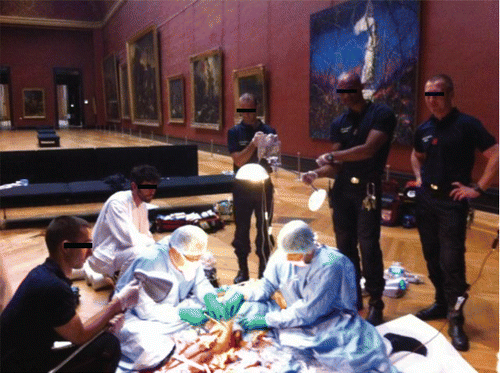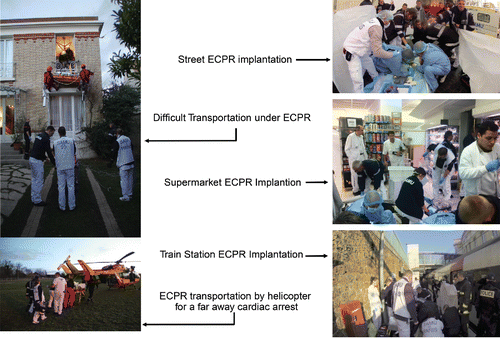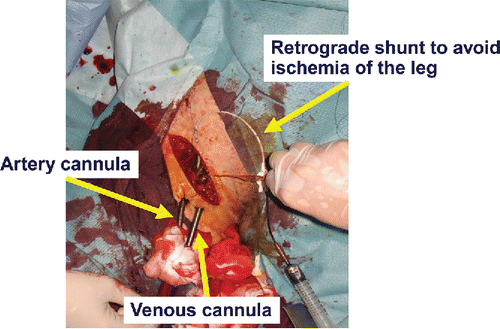Abstract
Introduction: Extracorporeal Cardiopulmonary Resuscitation (ECPR) is now considered for the treatment of refractory cardiac arrest. Case report: In an urban city like Paris, extraction times of in-hospital ECPR can be long for patients presenting with refractory cardiac arrest. Using the medicalized prehospital system, we developed a possible early prehospital ECPR implementation. This case report is an example of ECPR prehospital implementation in the Louvre Museum. Conclusion: Patients eligible for ECPR must be selected according to strict criteria. Further research is necessary to compare prehospital and in-hospital implementation.
Introduction
Extracorporeal Cardiopulmonary Resuscitation (ECPR) is now an option in the acute care of refractory cardiac arrest. It even appears in the latest international guidelines.Citation1 However, its therapeutic benefits are linked to early implementation.Citation2 We have developed the capability of ECPR implementation, on the scene of the cardiac arrest, in order to reduce the time in the low blood flow state of closed-chest CPR.Citation3 Herein, we report an ECPR implementation in a very uncommon place, the most visited museum in the world, The Louvre in Paris, to argue a new strategy.
The Service d'Aide Medical d'Urgence (SAMU) de Paris is a free public service in charge of the emergency medical services (EMS) calls and response. It has one medical dispatch center for the whole city. In this center, a doctor decides the most appropriate medical response for each call: medical advice, sending a general practitioner at the patient's home, directing the patient to the nearest emergency room, sending an ambulance, a basic life support (BLS) unit (firefighters), or a mobile intensive care unit (MICU). The MICU is composed of an emergency physician or an anesthesiologist intensivist, a nurse, and a paramedic. This team is allowed to perform all advanced life support (ALS) care such as: intubation, sedation, thrombolysis, EKG, giving adequate medication, etc. The physician on-site gives an oral complete status of the patient to the physician at the SAMU's dispatch center. According to the patient needs, the dispatch center is in charge of finding the most appropriate hospital with the specific service needed for each patient (direct transport to a cardiac cath lab for acute myocardial infarction, direct admission to an ICU for a comatose patient, etc.). Over the past few years, the SAMU de Paris has also developed an ECPR team. This specially trained team is composed of an emergency physician or anesthesiologist intensivist, a nurse anesthetist, and a paramedic. They are able to go directly to the site of the cardiac arrest using a dedicated vehicle with all the necessary equipment. ECPR is delivered using a transportable extracorporeal membrane oxygenation (ECMO) device (Cardiohelp©, Maquet™) with extensive monitoring.
Case Report
A 66-year-old male tourist collapsed at 4:35 pm in front of the art piece “La liberté guidant le peuple” by Eugene Delacroix. A nurse, tourist, also in the room, immediately identified the cardiac arrest (CA) and started CPR rapidly helped by firefighters (EMTs) from the Louvre. The first analyzed rhythm was ventricular fibrillation. Two shocks were delivered by the automatic external defibrillator (AED), without return of spontaneous circulation (ROSC). The EMTs started to bag ventilate the patient.
Unfortunately, access to the patient was difficult at this rush hour in one of the most overcrowded tourist attractions in Paris. At the SAMU MICU team arrival 19 minutes after the CA, the patient presented an asystole. Advance Life Support was pursued with intubation and IV epinephrine administration, following the international guidelines.Citation4 According to the local procedures of the EMS system at this time, the ECPR team was called after 10 minutes of ALS; the estimated extraction delay from the scene for inhospital ECPR was evaluated as being too long. Consequently, the ECPR team was sent out and ECPR implementation was started on scene 67 minutes after CA, under mechanical CPR by LUCAS 2™ (Physio control). The insertion was started by a femoral cut down to visualize the vessels. The cannulas were then inserted using the Seldinger technique. ECPR implementation took 23 minutes, without any difficulty (). Within 90 minutes of the collapse ECPR was implemented and circulatory assistance was satisfactory.
The patient was then transferred to an ICU where he rapidly developed multi-organ failure and coagulopathy despite optimal medical care. He died 24 hours after his admission without any possibility of organ donation.
Discussion
This case highlights a new therapeutic possibility for the management of refractory cardiac arrest: prehospital ECPR implementation.
Kagawa et al. have compared the survival between in-hospital and out-of-hospital cardiac arrest treated by ECPR.Citation5 They found that the delay between the CA and ECPR implementation was an independent factor of survival; this delay explains the difference between in-hospital and out-of-hospital CA survivors. It is now recognized that ECPR needs to be implemented within 60 minutes of CA.
For out-of-hospital CA, the delay to reach the hospital is a real challenge. The “load and go strategy” by paramedics can be used, but is not possible for all patients. For example, in this case, the extraction of a patient undergoing mechanical CPR was difficult due to the presence of many tourists, the configuration of the location (the Louvre has many stairs and long corridors to reach the extraction vehicle), and the busy traffic (between the Louvre and the closest hospital capable of delivering ECPR).
This “load and go” strategy has been described in an EMS system with MICU: the mean time for extraction from the scene of an OHCA and transportation to the hospital for inhospital ECPR was 57 minutes.Citation5 In another study, with an EMS system with only paramedics, the median times between CA and ECPR was around 60 minutes for only half of the patients.Citation6
The “load and go” strategy is, therefore, not the only way to go. This is why, in our EMS-based on the intervention of an MICU, we developed out-of-hospital ECPR implementation. This strategy can be an alternative for patients with difficult access, or too long a distance for in-hospital ECPR. As we have experienced, this strategy can be applied in multiple cases ( and ). For example, in this second illustration, we are able to implement ECPR in a supermarket, a train station, etc. Another advantage of developing out-of-hospital ECPR is to create equality between patients who live near an ECPR center and others who live further away. The scene of the CA can be reached by the ECPR team by car or helicopter; and once under ECPR the patient can be transported back to the hospital with less difficulty.
However, the selection of the patients is a real challenge. In 2008, the different French national scientific societies developed an algorithm of patient selectionCitation7. In 2015, we modified these guidelines due to the poor prognosis of patients presenting with asystole and no signs of life.Citation8 We therefore decided to keep the following inclusion criteria: patients presenting ventricular fibrillation as initial rhythm with a no flow time less than 5 minutes, or presence of signs of life, or neuroprotected patients (intoxication, hypothermia, anesthesia).
Over the past few years, the definition of refractory cardiac arrest has also evolved. Previously, refractory cardiac arrest was defined by the absence of ROSC after 3O minutes of Advance Life Support. Recently, the analysis of a large cohort has shown that the probability of ROSC after 24 minutes of CPR is very low.Citation9 This finding therefore supports the new concept of refractory cardiac arrest defined by the absence of ROSC after 20 minutes of CPR and use of an AED.
With this patient selection, and an aggressive strategy, in a preliminary report we found 31% of survivors with good neurological prognosis.Citation10 Another interesting point is the proportion of patients developing brain death status with possible organ donation. Indeed, in the same report, we found more than 30% of patients developed brain death, with 9% of organ donation.
In conclusion, out-of-hospital ECPR implementation is an innovative solution for the management of refractory cardiac arrest. This strategy needs a special organization and trained doctors (emergency physicians), but it can save lives. An international randomized study comparing prehospital and in-hospital ECPR implementation has recently been started to further evaluate the potential benefit of this strategy.
References
- Link MS, Berkow LC, Kudenchuk PJ, et al. Part 7: Adult Advanced Cardiovascular Life Support 2015 American Heart Association Guidelines Update for Cardiopulmonary Resuscitation and Emergency Cardiovascular Care. Circulation. 2015;132:S444–64.
- Wang C-H, Chou N-K, Becker LB, et al. Improved outcome of extracorporeal cardiopulmonary resuscitation for out-of-hospital cardiac arrest – A comparison with that for extracorporeal rescue for in-hospital cardiac arrest. Resuscitation. 2014;85:1219–24.
- Lamhaut L, Jouffroy R, Soldan M, et al. Safety and feasibility of prehospital extra corporeal life support implementation by non-surgeons for out-of-hospital refractory cardiac arrest. Resuscitation. 2013;83:1525–9.
- Soar J, Nolan JP, Böttiger BW, et al. European Resuscitation Council Guidelines for Resuscitation 2015. Resuscitation. 2015;95:100–47.
- Kagawa E, Inoue I, Kawagoe T, et al. Assessment of outcomes and differences between in- and out-of-hospital cardiac arrest patients treated with cardiopulmonary resuscitation using extracorporeal life support. Resuscitation. 2010;81:968–73.
- Poppe M, Weiser C, Holzer M, et al. The incidence of “load&go” out-of-hospital cardiac arrest candidates for emergency department utilization of emergency extracorporeal life support: A one-year review. Resuscitation. 2015;91:131–6.
- Recommandations sur les indications de l'assistance circulatoire dans le traitement des arrêts cardiaques réfractaires. Ann Fr Anesth Réanimation. 2009;28:182–6.
- Raux M, Lamhaut L, Bougon D, et al. ECLS hospitalière pour arrêt cardiaque réfractaire préhospitalier: analyse intermédiaire. 2015. Available at: http://www.sfmu.org
- Grunau B, Reynolds J, Scheuermeyer F, et al. Relationship between Time-to-ROSC and survival in out-of-hospital cardiac arrest ECPR candidates: when is the best time to consider transport to hospital? Prehosp Emerg Care. 2016 Sep-Oct;20(5):615–22.
- Lamhaut L, Jouffroy R, Idialisoa R, et al. Abstract 19833: A new therapeutic strategy for refractory cardiac arrest including prehospital ecmo: a comparison study. Circulation. 2015;132:A19833.



